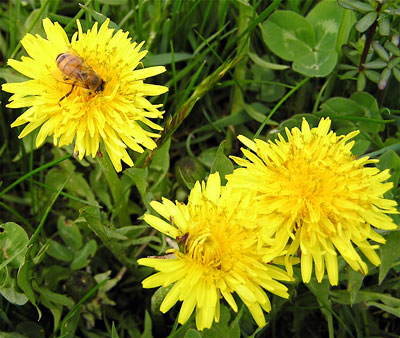 |
| Cut dandelion greens before the plants flower. English photo. |
By Chris Knapp
There is something intrinsically wonderful about wild food. Over the years my wife and I have shared wild plants with countless people. Folks bend down to the earth, pick a plant and put it in their mouths. Aha! An essential truth about our human relationship with the earth comes into focus: We have nothing, we need everything, and the earth is a treasure trove of gifts.
For many, the wild foods experience stops here with a trailside nibble, an explosion of taste on the tongue. A worthy experience, for sure.
For my family, however, from the first early spring dandelion through the heart of fiddlehead and stinging nettle season, wild greens comprise serious sustenance. Once we became accustomed to these nutrient-packed foods, many staple domestic greens paled in comparison. In early May I would not trade my dandelion salad topped with trout lily and colt’s foot flowers for all the hard-earned lettuce in the cold frames of Maine. (If there is wisdom in the rodent family, we can take a cue from the unidentified furry creature that devoured every dandelion, root and all, in our subterranean greenhouse this January before even considering the chard and kale.)
Of course, everything has its season. By the time July rolls around, many of the wild plants have faded, toughened or grown bitter, and we are cherishing the first peas and greens from our garden. So watch out! Don’t miss it! Remember the gift and go pick it.
Here are five wild plants that will nourish your body and feed your soul as they connect you to the magic rhythm of spring.
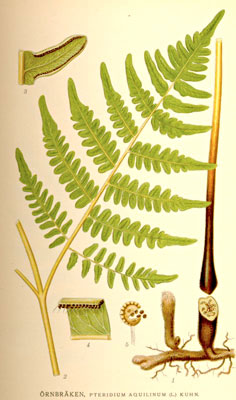 |
| Bracken ferns are edible when young but must be boiled and the water poured off. Reproduction of a painting by Swedish botanist C. A. M. Lindman. https://en.wikipedia.org/wiki/Bracken_fern |
Dandelion, Taraxacum officinale
Everybody knows the humble dandelion, but still it is widely underused. In late April we closely watch the southern side of our root cellar, where snow melts fast and last year’s dandelion roots are quick to sprout a sturdy new top. In dandelion season I always keep a dull pocketknife with me. Dandelions should be cut like a head of lettuce, below the white crown and above the root, so that the clump of leaves is held together at the bottom. This makes rinsing them much easier. Dandelions can be “dug” from the time they are a few inches high until their developing flower buds appear, tucked in at the base of the rosette of leaves. I use a dull knife, because a sharp tool in contact with the earth quickly becomes dull anyhow.
But aren’t dandelions bitter? Don’t worry, that reaction goes away! My wife and I used to lead a 5-month wilderness-based semester program for Kroka Expeditions. In April I would enthusiastically introduce students to dandelion, and many would find them bitter. By the end of their month-long trip down the Connecticut River, they would inform me that “the dandelions have lost their bitterness!” In the last weeks of the program these high school students could be seen, dull knife in hand, scurrying about the fields gathering breakfast, lunch and dinner.
I knew I was a dandelion devotee when I mixed its seed with the clover we raked into a newly created field.
Here is a typical menu for my family during dandelion season: breakfast – grated, freshly dug parsnip stir-fried with a mess of dandelion greens and a few fresh eggs; lunch – a salad of grated root vegetables and sauerkraut over a base of finely chopped dandelion; supper – sautéed dandelion greens and onions with beans and cheese. Cooked or raw, no matter how you slice it or spice it, eating dandelions infuses your body with iron-rich, liver-cleansing sustenance three meals a day.
Bracken Fern, Pteridium aquilinum
Please see important information about the possible toxicity of bracken fern in the letters section of the summer 2013 issue of The Maine Organic Farmer & Gardener.
This is not the bright green ostrich fern fiddlehead (Matteuccia struthiopteris) commonly seen at roadside stands. Bracken is the ostrich’s little known ugly brother. Though it lacks the visual appeal, bracken tastes great, occupies a much larger ecological niche, and has a longer window of harvest than the ostrich fern.
As bracken unfurls, it looks like a bird’s claw with only three fingers. We harvest bracken fiddleheads when their stalk is 2 to 8 inches tall. If the stem does not snap easily at the base, it is too tall. You can extend the harvest window to a point by snapping the stem higher, just as you would a too-tall spear of asparagus.
Bracken, like all plants, responds to fertility, so its size varies with the soil, although it seems to grow in a wide variety of places. I seek the big fiddleheads often growing along old woods roads where a disturbance has let in additional sunlight. When harvesting bracken, we are careful to leave three plants for every one we take.
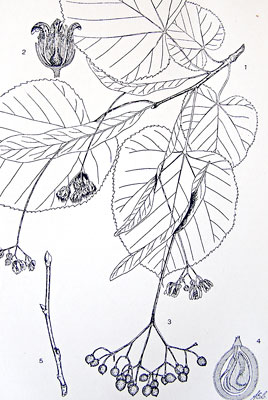 |
| Young linden leaves are tender, mild and nutty. From Trees of Northeastern United States, Native and Naturalized, by H.P. Brown, Ph.D., The Christopher Publishing House, Boston, 1938. |
We pick a large bundle, boil a pot of water, then put in the fiddleheads with their stems and boil for 5 to 7 minutes. We then pour off the tea-colored water. Bracken contains an enzyme, which, if ingested in quantity, destroys vitamin B1. Cooking destroys this enzyme; do not eat bracken raw.
Bracken fiddleheads are a hearty vegetable, more like eating broccoli than greens. In early May, such a vegetable is a welcome addition to the diet. My kids, ages 2 and 4, love them.
American Basswood, Tilia americana
Many tree leaves are edible, but basswood, a true “lettuce tree,” is the only one we eat in quantity. The leaves, from the time they unfurl until they are about 6 inches wide, are tender, mild and nutty. I have never met a kid or adult who disliked the flavor. Eventually the leaves darken and toughen, but for a few weeks in mid- to late-May, basswood forms the base of many of our salads. We purposefully coppice some of our basswood trees, creating basswood bushes from the vigorous suckers to keep the leaves in reach and lengthen the harvest window as the tree continues to send up new suckers.
Basswood grows in most eastern forest ecologies, especially along field edges, roadsides, stonewalls and riverbanks. And, if you are out in winter and can’t wait for spring, chew some basswood buds; they are delicious although a bit mucilaginous.
Stinging Nettle, Urtica dioica
Just when I begin to tire of steamed dandelion, along comes stinging nettle – a bountiful, dark, rich green than steams into a tender (sting-free!) delight. The nearest patch to us is 2 miles away, so I generally harvest a full plastic shopping bag at a time and store the nettles in our root cellar for up to a week. I wear thin rubbery gloves and, grabbing the tops of the nettles in clumps, slice off the top two pairs of opposite leaves with a sharp knife. I pack these mini bundles, with the stems all going in the same direction, neatly into my bag or basket. Don’t be bashful about taking too much; you are just mowing the lawn. The patch will grow back quickly and the plants will all still flower.
At home we chop the nettles finely, stems included, then steam them with a good amount of water. Steaming completely nullifies the stinging. (If you do get pricked during picking or preparation, scrubbing the site with common plantain leaves works wonders.)
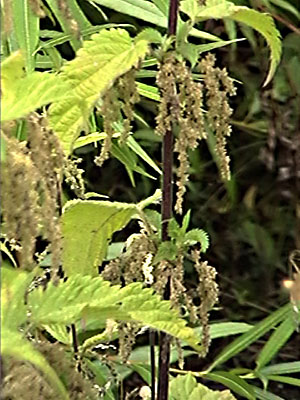 |
| Try chopped, steamed nettles with butter and salt or beans and oil. English photo. |
The sage advice of Euell Gibbons – that almost everything is better with butter and salt – holds true for nettles. I also like nettles with beans and oil, or as the base of an omelet, or in soup. They are a versatile green loaded with nutrients.
Lamb’s-Quarters, Chenopodium album
Many folks know and enjoy – or know and despise – this common garden weed. It has a wonderful/horrible habit of dropping thousands of little black seeds and sprouting wherever the soil is disturbed.
As a steamed green, lamb’s-quarters is unparalleled. You can harvest lamb’s-quarters as soon as it is big enough to bother with. The best window is when the plant is somewhere between 6 and 10 inches high, as the stem is still tender and can be cooked with the leaves. After this stage, you can continue to harvest the upper tufts of stems and leaves, but the lower stem will be tough.
We like this plant so much that we extend its season by topping a large, vigorous plant that is getting ready to flower, then use the multiple young side shoots that mature a few weeks later.
Though reasonably tasty raw, lamb’s-quarters lightly steamed with some butter and salt is incredible. I struggle within myself as I weed it out of garden beds, because we love it so, but one can’t let it grow everywhere.
One spring I rode my bike past a roadside hoophouse that appeared untended. The rank growth of something inside perked my foraging instincts. I peeped in to see a lush crop of very early lamb’s-quarters. I found the farmer and asked if I could harvest the crop. I told him I would cut the tops off first to ensure clean greens, then go back and pull the plants and toss them on his compost. He was agreeable and even helped me harvest some. When we got done I left him with a big bundle of the finest tops. He knew where I was working, and the next day I found a note in the front seat of my car thanking me profusely, claiming that in his 40 years of farming he had not eaten a better bowl of greens.
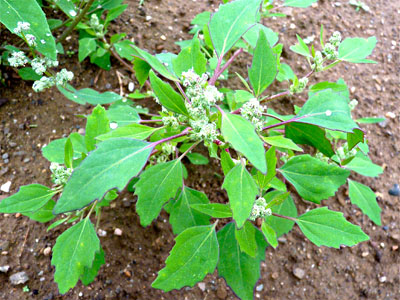 |
| Young lamb’s-quarters tastes good. You can top taller plants and eat the side shoots. English photo. |
Many other noteworthy plants appear in spring as a steady progression and magical rhythm of wild foods. These plants can do more than enrich our diets: I cherish my 2-mile run up to the base of Tater Mountain where a big patch of nettles has invaded an abandoned homestead. I count myself lucky for all the hours spent squatting next to our little swollen stream, freezing my hands as I wash dandelion greens in the fading light. And spring would not be complete without a Sunday morning family pilgrimage to the fiddlehead flats where we take a break from the long springtime hours of domestic agriculture to bend down and pick the gift. Just as our gardens are invaluable, so too is the experience of the wild, and the sense of gratitude it inspires.
Chris and Ashirah Knapp offer classes in traditional and sustainable living skills at their Koviashuvik Local Living School (www.koviashuvik.com) in Temple, Maine. They are also longtime participants in the Folk Arts Area at the Common Ground Country Fair.
